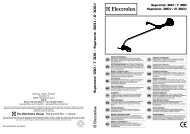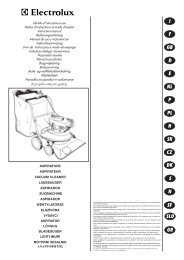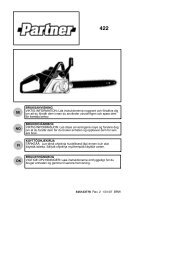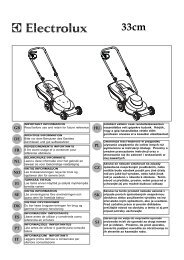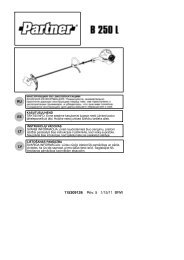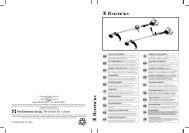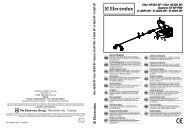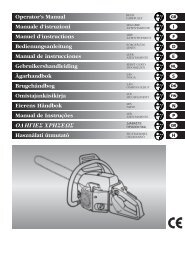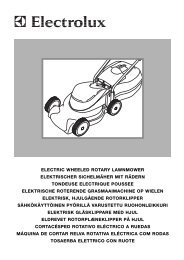OM, Partner, Novolette silent, 964944017, 2010-01, Lawn Mower ...
OM, Partner, Novolette silent, 964944017, 2010-01, Lawn Mower ...
OM, Partner, Novolette silent, 964944017, 2010-01, Lawn Mower ...
Create successful ePaper yourself
Turn your PDF publications into a flip-book with our unique Google optimized e-Paper software.
Mowing<br />
A well-kept lawn needs mowing once a week, or even more frequently<br />
during the growing season. The best results are obtained by frequent<br />
mowing when the grass is dry. The mowing should be done at normal<br />
walking pace, in straight lengths, with the cuts overlapping. The height of the<br />
cut grass should not be too low. The best results is obtained with the cutting<br />
height set at one of the two positions in the middle.<br />
Setting the cutting height. Fig 3<br />
Four different cutting heights are available. Adjustment is carried out by<br />
pulling out the setting knobs and replacing them in the desired position.<br />
Check that the setting is the same on both sides.<br />
Adjusting the cutting function. Figs 4 and 5<br />
The mower is correctly adjusted when delivered. There is a gap of a few<br />
hundredths of a millimeter between the cylinder blades and the bottom<br />
blade. The blades are of hardened steel and retain their sharpness over<br />
many years if the mower is correctly used and well maintained.<br />
Stones and other objects can cause damage to the cylinder blades and the<br />
bottom blade. Small burrs can arise which cause a scraping sound. This<br />
sound disappears gradually if the damage is only slight.<br />
Small blemishes (burrs) can be removed using a small file or similar. The filing<br />
must be done with care so that the cutting edges of the blades are not<br />
damaged. In cases of serious wear or damage, the blade cylinder and<br />
bottom blade must be returned for round grinding, flat grinding or<br />
replacement.<br />
Adjustment may become necessary if the mower starts to cut unevenly or<br />
make more noise after a long period of use. Turn the mower upside down<br />
and, as in fig 4, locate any damage to the blades. File away burrs and<br />
uneven parts (taking care not to damage the cutting edges). Then test the<br />
blade setting by cutting paper. Use a paper quality which matches the paper<br />
in these instructions.<br />
Loosen both screws until the cylinder can just be rotated freely. Start to<br />
tighten the left-hand screw (fig. 5) and rotate the cylinder until it begins to<br />
make light contact with the bottom blade. Then loosen the screw so that the<br />
cylinder just leaves the bottom blade and rotates quietly. Repeat this<br />
procedure on the right-hand side. Check the setting as before, with paper.<br />
Accurate adjustment gives the best mowing results.<br />
Maintenance<br />
The mower should be cleaned each time it is used. A deposit of grass on the<br />
blades impedes the cutting action.<br />
Lubricate the blade edges and mowing parts at the end of the season. The<br />
mower should be stored in a dry place.<br />
Small repairs can usually be carried out by the owner. If assistance is<br />
needed with service or spare parts, contact the nearest retailer.<br />
The product liability act does not apply in cases of misuse or faulty repair<br />
work. Use only genuine spare parts.<br />
Grass collector. Fig 6<br />
A grass collector is available as an extra accessory. Collection functions<br />
best in dry weather with the mowing done at an even, brisk walking pace.




